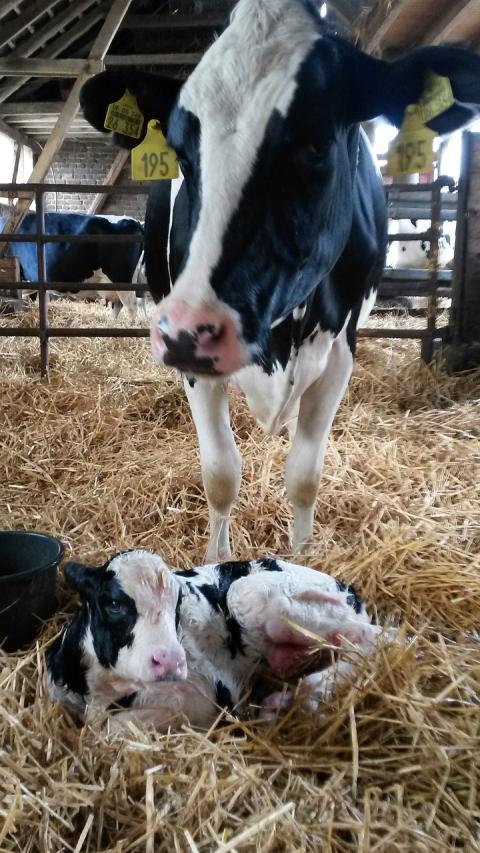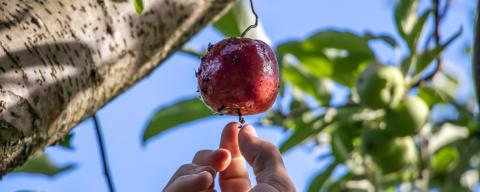SHARE

The time has arrived!! The calf you have anxiously waited for over the last nine months is about to enter the world. But what should you do to help the cow and calf? The following is a list of things you should do.
Preparation
- Move the cow to a private area or large pen before calving. This will allow the cow to escape the other cows during the birthing process.
- Make sure the pen the cow is in has clean, dry bedding. Remember the calf is in a warm temperature-controlled, clean environment and about to enter a potentially dirty environment. Calves can take in pathogens and other compounds right after birth.
- Make sure the cow is comfortable and relaxed. She may begin nesting and pawing at the ground.
- Make sure to have dry towels and iodine to dip the navel of the calf.
- Try to make sure you have either a bucket milker available or can move the cow to be milked immediately after calving.
Presentation of the calf
- A balloon-like sac full of water should be present first, then the calf should present herself with front legs and head forward between them. Almost like she is diving. If there is a different presentation, contact an experienced person or call your veterinarian.
- When the calf is out, make sure it is breathing by rubbing it vigorously with a towel. Clear her mouth of any fluid.
- In the case of twins, the first calf will usually present herself in this way, but the second will present herself with rear legs first, as she comes out it is common for her to breathe in some meconium (calf feces) therefore, making sure this calf is breathing by clearing her mouth.
Navel disinfection
- Make sure that you dip the navel with an iodine navel dip (7% is preferred). However, this is difficult to acquire 7% iodine due to new regulations. Do not use teat dips because teat dips are designed to maintain skin softness whereas, navel dips are required to dry the navel quickly to prevent infection. There are some new navel dips available such as 2% chlorhexidine.
- (Some farms practice dipping hooves in iodine to reduce potential infection there as well. Hooves are soft at birth. However, no data indicate any positives or negatives in this practice.)
Harvesting colostrum
- As soon as possible, harvest the colostrum from the cow. If the cow has an internal teat seal, make sure you get all of the sealant out while stripping the cow. Once harvested, test the colostrum using a colostrometer or refractometer. Colostrum should test greater than 50g/L IgG or better than 22% on the refractometer. (See the colostrum fact sheet for more details.)
Feeding the calf
- Get the colostrum into the calf as soon as possible, Holsteins and Brown Swiss should get a minimum of 4 quarts while Jerseys need about 2.5 quarts. Try to get at least 2/3 into the calf immediately and the rest within six hours. This is because the calf needs the antibodies and also the fat and water that colostrum provides.
- What if the cow does make enough?
- Sometimes this happens. Make sure to have frozen colostrum available that can be slowly thawed or a colostrum-based colostrum replacer.
- What if the calf does not drink it all?
- It is imperative to get all the colostrum into the calf. If necessary, this might include stomach tubing. Make sure that you know how to stomach tube a calf or have someone trained in this do it. There is no difference in immune status in calves that suckled a bottle or were stomach-tubed colostrum.
Usually, then remove the calf to a clean dry hutch or pen. Deep bedding is preferred. If it is cold, and the calf is dry, put a calf coat on the calf. You can begin feeding milk, milk replacer, water, and starter grain at this time. Please see the complementary fact sheets about those topics.
Extension Services & Tools That Help NH Farmers Grow
Newsletters: Choose from our many newsletters for production agriculture
Receive Pest Text Alerts - Text UNHIPM to (866) 645-7010
Contact
Dairy Production State Specialist
Professor
Email: Peter.Erickson@unh.edu
Phone: (603) 862-1909
Office: Keener Dairy Research Building, Durham, NH 03824
Topics
Types

